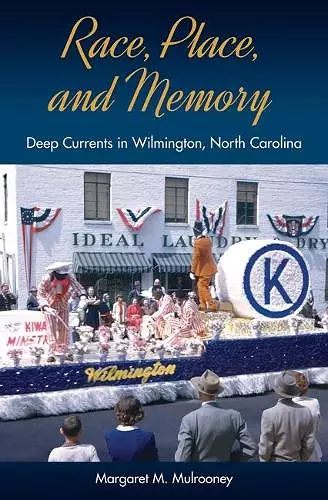Race, Place, and Memory
Deep Currents in Wilmington, North Carolina
Format:Paperback
Publisher:University Press of Florida
Published:15th Mar '22
Should be back in stock very soon

A revealing work of public history that shows how communities remember their pasts in different ways to fit specific narratives, Race, Place, and Memory charts the ebb and flow of racial violence in Wilmington, North Carolina, from the 1730s to the present day.
Margaret Mulrooney argues that white elites have employed public spaces, memorials, and celebrations to maintain the status quo. The port city has long celebrated its white colonial revolutionary origins, memorialized Decoration Day, and hosted Klan parades. Other events, such as the Azalea Festival, have attempted to present a false picture of racial harmony to attract tourists. And yet, the revolutionary acts of Wilmington’s African American citizens—who also demanded freedom, first from slavery and later from Jim Crow discrimination—have gone unrecognized. As a result, beneath the surface of daily life, collective memories of violence and alienation linger among the city’s black population.
Mulrooney describes her own experiences as a public historian involved in the centennial commemoration of the so-called Wilmington Race Riot of 1898, which perpetuated racial conflicts in the city throughout the twentieth century. She shows how, despite organizers’ best efforts, a white-authored narrative of the riot’s contested origins remains. Mulrooney makes a case for public history projects that recognize the history-making authority of all community members and prompts us to reconsider the memories we inherit.
“Simply put, in cultural, political, and social environments rife with debates and disputes regarding Confederate-themed commemorative and celebratory statues and monuments in public venues, Mulrooney’s book deserves wide attention. . . . Essential.”—Choice
“Race, Place, and Memory should push more historians to think about the locales in which public memory is contested ground.”—H-Net
“A well-researched and well-documented must-read for anyone interested in the history of race and place, and it provides an invaluable resource for understanding Wilmington.”—Journal of American History
“Clear and undisputed documentation of the deep and protracted racial fault line in the port city. . . . The book, moreover, will also undoubtedly expose many new individuals to the important work and scholarship of professional public historians.”—Journal of African American History
“Recommended reading for anyone who wants to understand the importance and power of public history in creating a usable past.”—Journal of Southern History
“A valuable addition to our understanding both of Wilmington’s complex and often disturbing racial past and of the power of public memory in directing a community’s future for good or otherwise.”—North Carolina Historical Review
""An immensely welcome longitudinal study of the intersection of race, place, and historical memory in Wilmington, North Carolina. Richly researched, beautifully written, and deeply analytical, Mulrooney’s study is a tour de force.""—John David Smith, editor of Interpreting American History: Reconstruction
""With clear and compelling prose, Mulrooney dives beneath the seemingly calm waters of a ‘progressive city’ to find evidence that racialized violence and memory-making were foundational to southern settlement and development rather than a mere aberration.""—Derek H. Alderman, coauthor of Civil Rights Memorials and the Geography of Memory
ISBN: 9780813068688
Dimensions: 233mm x 155mm x 21mm
Weight: 569g
374 pages